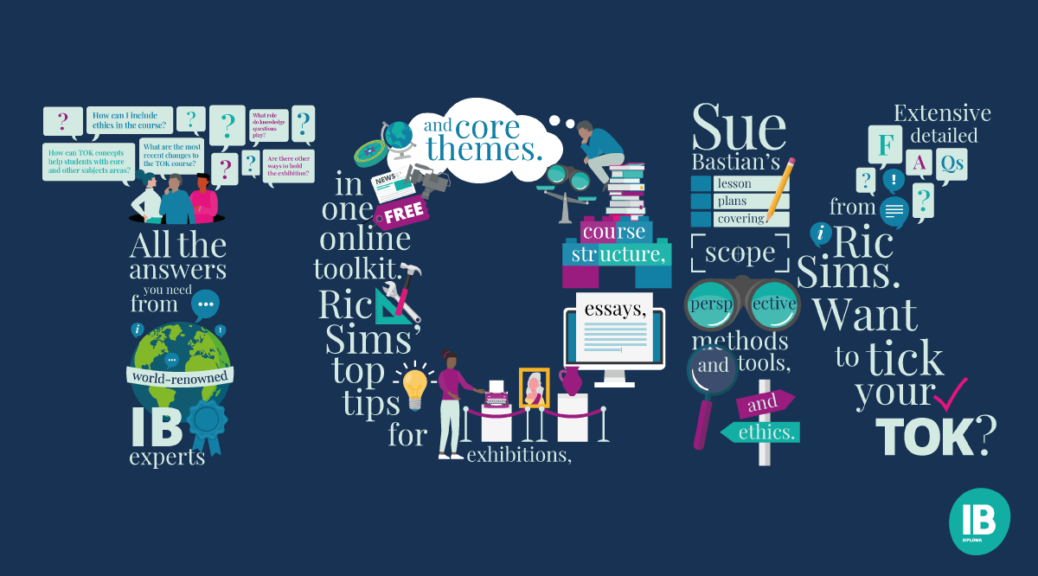All posts by Miss Sones
TOK Exhibition Exemplars
Use these models to address what the examiners are looking for when they mark your TOK Exhibition.
Y12 – Y13 course Planner
Term One
Core Theme – Knowledge and the Knower
Term Two
Knowledge and Language
Term Three
Knowledge and Technology
TOK GLOSSARY
Epistemology – the study of knowledge (T.O.K.). Exploring the nature of knowledge and the extent of knowledge.
Usw this link for an in depth overview of epistemology:
Epistemology
This link is also useful for more detailed explanations of the terminology listed below.
Core Concepts
Belief Truth Justification Knowledge
ToK Key Concepts
Certainty Culture Evidence Explanation Interpretation Justification Objectivity Perspective Power Responsibility Truth Values
Ways of Knowing
Language Reason Sense Perception Memory Faith Intuition Imagination Emotions
Pragmaticism Relativism Empiricism Rationalism Naturalism Skeptivism
Certainty Coherentism Contextualism Dogmatism Experience Fallibilism Foundationalism Induction Infallibilism Infinitism Perspectivism Rationality Reason Solipsism
Different Types of Knowledge
- Factual – knowledge that can be evidenced by fact
- Conceptual – knowledge that is based upon a theme, categories, etc.
- Procedural – knowledge on how to do something
- A Posteriori knowledge – from personal experiences
- A Priori knowledge – from reason
- Expert knowledge – deep knowledge from a discipline
- Empirical Knowledge – from senses alone
- Encoded Knowledge – knowledge encoded in symbols
creating the tok exhibition
What is the TOK exhibition?
- The TOK exhibition is an internal assessment task (marked by your teacher, and moderated by the IB), representing ⅓ of your overall mark in TOK.
- The aim is to show how TOK manifests itself in the world around us.
- To do this, you choose an IA prompt (from a list of 35 options), select 3 specific real-world ‘objects’, and write a commentary connecting the objects to your prompt.
- During Y12 you will write ‘mini’ TOK exhibition commentaries on specified questions to prepare you for the real write up and get feedback on your ability to address TOK in your writing.
- It is recommended that the context for your commentary is based on the core or optional themes (knowledge & and the knower, knowledge & language or knowledge & technology).
10 Important considerations before you begin
- Your objects must be different from those of the other students in your class.
- You MAY choose the same IA prompt as another student in your class.
- You should NOT alter the IA prompt in any way.
- Choose objects that are of personal interest to you and relate to you and your real life context.
- Objects must belong within a specific time & place (rather than be generic)
- Objects may be something that students have created themselves (e.g. a piece of work – such as an EE, or a painting for their DP visual art course), but may not be created specially for the exhibition.
- Objects can be physical or digital.
- The overall word count for the commentary is 950 words.
- Images, ideas, and quotes should all be referenced.
- Your teacher will support you during the process of creating the exhibition, with at least one initial meeting, and one check of a draft you provide – for which they can provide written or oral feedback.
What kind of objects can be selected?
You can select a wide variety of objects for your exhibition. Here are some examples. If you are still unsure with what an objects you can use. Please refer to your TOK teacher.
- An piece of artwork or musical composition you created
- A history book
- A tweet from the Indian Prime Minister
- A tree from your garden
- Statistics
- A picture you have taken yourself
- A picture of your grandparents
- An episode of Booker’s Black Mirror
TOK EXhibition mark scheme
How your blog posts will be assessed.
Does the practice exhibition commentary (your blog post) demonstrate how TOK manifests itself in the world around us?
| Level 5 Excellent 9-10 | Level 4 Good 7-8 | Level 3 Satisfactory 5-6 | Level 2 Basic 3-4 | Level 1 Rudimentary 1-2 | 0 |
| It clearly and explicitly explains the links between the object and the IA prompt, and explicit references are made to the selected IA prompt. | It explains the link between the object and the IA prompt, although this may lack precision and clarity in parts. | There is an attempt to explain the link between the object and the IA prompt, although this may not be fully convincing. | Basic links between the objects and the IA prompt are made, but these are unconvincing and/or unfocused. | The links offered between the object and the selected IA prompt are minimal, tenuous, or not clear. | Did not reach the descriptors of the levels shown. |
| There is a strong justification why the object has been chosen for the practice exhibition. | There is a justification why the object has been chosen for the practice exhibition. | There is some justification why the object has been chosen for the practice exhibition. | There is a superficial justification for why the object has been chosen for the practice exhibition. | There is very little justification offered for why the object has been chosen for the exhibition. | |
| All the points in the commentary are well-supported by evidence. | Many of the points in the commentary are supported by appropriate evidence. | Some of the points in the commentary are supported by evidence. | Appropriate evidence is not included. | Points in the commentary are highly descriptive and unsupported. | |
| Key characteristics | Key characteristics | Key characteristics | Key characteristics | Key characteristics | Key characteristics |
| Convincing, lucid, precise | Focused, relevant, coherent | Adequate, competent, acceptable | Simplistic, limited, underdeveloped | Ineffective, descriptive, incoherent |
Theory of knowledge subject guide 2022-23
Please use this guide to remind you of the key assessments and teaching content.
How we explore the themes & AOKs – The knowledge framework
| Nature and scope | Nature and scope deals with the type of knowledge found within the themes and areas of knowledge, the purpose of its knowledge, why it is important for us as knowers, and the kind of problems it helps us solve. |
| Perspectives | Perspectives deals with the way our personal and societal perspectives inform the way we view the themes and areas of knowledge, how knowledge changes over time, and how context affects what we know. |
| Methods and tools | Methods and tools deals with the practices used to produce knowledge within the themes and areas of knowledge, the cognitive and material tools that create ideas, and how knowledge is communicated and shared between knowers. |
| Ethics | Ethics deals with the relationship between knowledge and values within the themes and areas of knowledge, how our knowledge influences our moral outlooks, and the ethical constraints placed on the way knowledge is produced. |
How we express our understanding – The 12 key concepts
| Certainty | Evidence | Explanation | Culture | Interpretation | Justification |
| Perspective | Power | Objectivity | Responsibility | Truth | Values |
How the course is organized – The TOK diagram







